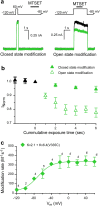Independent movement of the voltage sensors in KV2.1/KV6.4 heterotetramers
- PMID: 28139741
- PMCID: PMC5282584
- DOI: 10.1038/srep41646
Independent movement of the voltage sensors in KV2.1/KV6.4 heterotetramers
Abstract
Heterotetramer voltage-gated K+ (KV) channels KV2.1/KV6.4 display a gating charge-voltage (QV) distribution composed by two separate components. We use state dependent chemical accessibility to cysteines substituted in either KV2.1 or KV6.4 to assess the voltage sensor movements of each subunit. By comparing the voltage dependences of chemical modification and gating charge displacement, here we show that each gating charge component corresponds to a specific subunit forming the heterotetramer. The voltage sensors from KV6.4 subunits move at more negative potentials than the voltage sensors belonging to KV2.1 subunits. These results indicate that the voltage sensors from the tetrameric channels move independently. In addition, our data shows that 75% of the total charge is attributed to KV2.1, while 25% to KV6.4. Thus, the most parsimonious model for KV2.1/KV6.4 channels' stoichiometry is 3:1.
Conflict of interest statement
The authors declare no competing financial interests.
Figures





Similar articles
-
The electrically silent Kv6.4 subunit confers hyperpolarized gating charge movement in Kv2.1/Kv6.4 heterotetrameric channels.PLoS One. 2012;7(5):e37143. doi: 10.1371/journal.pone.0037143. Epub 2012 May 17. PLoS One. 2012. PMID: 22615922 Free PMC article.
-
Modulation of Closed-State Inactivation in Kv2.1/Kv6.4 Heterotetramers as Mechanism for 4-AP Induced Potentiation.PLoS One. 2015 Oct 27;10(10):e0141349. doi: 10.1371/journal.pone.0141349. eCollection 2015. PLoS One. 2015. PMID: 26505474 Free PMC article.
-
Functional control of heteromeric Kv2.1/6.4 channels by the voltage sensor domain of the silent Kv6.4 subunit.J Physiol. 2025 Jun;603(12):3519-3532. doi: 10.1113/JP288376. Epub 2025 Jun 5. J Physiol. 2025. PMID: 40471226 Free PMC article.
-
Dynamic regulation of the voltage-gated Kv2.1 potassium channel by multisite phosphorylation.Biochem Soc Trans. 2007 Nov;35(Pt 5):1064-8. doi: 10.1042/BST0351064. Biochem Soc Trans. 2007. PMID: 17956280 Review.
-
Kv5, Kv6, Kv8, and Kv9 subunits: No simple silent bystanders.J Gen Physiol. 2016 Feb;147(2):105-25. doi: 10.1085/jgp.201511507. Epub 2016 Jan 11. J Gen Physiol. 2016. PMID: 26755771 Free PMC article. Review.
Cited by
-
The S6 gate in regulatory Kv6 subunits restricts heteromeric K+ channel stoichiometry.J Gen Physiol. 2018 Dec 3;150(12):1702-1721. doi: 10.1085/jgp.201812121. Epub 2018 Oct 15. J Gen Physiol. 2018. PMID: 30322883 Free PMC article.
-
Altered expression of KCNG3 and KCNG4 in Hirschsprung's disease.Pediatr Surg Int. 2019 Feb;35(2):193-197. doi: 10.1007/s00383-018-4394-2. Epub 2018 Nov 1. Pediatr Surg Int. 2019. PMID: 30386900
-
A Kv2 inhibitor combination reveals native neuronal conductances consistent with Kv2/KvS heteromers.Elife. 2025 May 27;13:RP99410. doi: 10.7554/eLife.99410. Elife. 2025. PMID: 40423692 Free PMC article.
-
What is the correct stoichiometry of Kv2.1:Kv6.4 heteromers?Proc Natl Acad Sci U S A. 2020 Nov 24;117(47):29288-29289. doi: 10.1073/pnas.2017827117. Epub 2020 Oct 20. Proc Natl Acad Sci U S A. 2020. PMID: 33082224 Free PMC article. No abstract available.
-
Oddballs in the Shaker family: Kv2-related regulatory subunits.J Gen Physiol. 2018 Dec 3;150(12):1599-1601. doi: 10.1085/jgp.201812251. Epub 2018 Nov 16. J Gen Physiol. 2018. PMID: 30446508 Free PMC article.
References
-
- Hille B. Ionic channels of excitable membranes. 2 edn (Sinauer Associates, 1991).
-
- Bezanilla F. The voltage sensor in voltage-dependent ion channels. Physiol. Rev. 80, 555–592 (2000). - PubMed
-
- Papazian D. M., Timpe L. C., Jan Y. N. & Jan L. Y. Alteration of voltage-dependence of Shaker potassium channel by mutations in the S4 sequence. Nature 349, 305–310 (1991). - PubMed
-
- Long S. B., Campbell E. B. & MacKinnon R.. Crystal structure of a mammalian voltage-dependent Shaker family K+ channel. Science 309, 897–903 (2005). - PubMed
-
- Seoh S. A., Sigg D., Papazian D. M. & Bezanilla F. Voltage-sensing residues in the S2 and S4 segments of the Shaker K+ channel. Neuron 16, 1159–1167 (1996). - PubMed
Publication types
MeSH terms
Substances
LinkOut - more resources
Full Text Sources
Other Literature Sources

